As you will have seen from previous posts, our project team are busy trying to find out as much as we can about the size and shape of medieval horse types from their skeletons. However, warhorses also had exoskeletons (external skeletons). While we might think of animals with exoskeletons as being creatures such as insects and crabs, warhorses had artificial exoskeletons in the form of armour. What can horse armour tell us about stature and shape of the horse that it fitted?
On the face of it, this sounds easy. The size of armour surely tells us a lot about size of horses selected for warfare and jousting. When one starts to examine the prospect more closely, however, some difficulties emerge. Leg lengths tell us most about withers heights, but horses didn’t wear greaves. Peytrals and cruppers certainly tell us a bit about the width of a horse’s chest or rump, respectively, but they don’t tell us much about height as they differ greatly in design in that respect. The crinet on the neck is designed to expand and contract with head movement, so there are not appropriate fixed points to measure. The other big problem with horse armour is its rarity: pieces survive in fairly small numbers, mainly in important museum collections. We are going to take measurements where we can, but those elements are unlikely to yield the datasets we need.
Shaffrons, on the other hand, survive it quite large numbers and were fitted quite closely to the horse’s face, with just a little paddling in between. They might give us lots of data on the size and shape of horse’s heads.
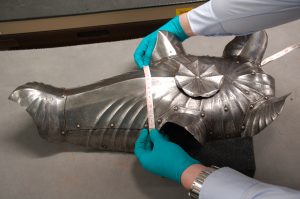
A 16th Century shaffron being measured in the collections of the Royal Armouries (Photo: O. Creighton).
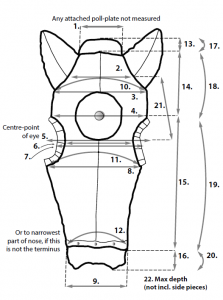
We are taking many measurements, both in straight lines and in contour between key landmarks on the shaffrons.
Deciding what to measure on shaffrons is not easy as they also vary in design quite considerably. Some extend fully from the back of the head to the nose, but then have a wide range of designs around the nasal area. Some ‘half shaffrons’ don’t extend as far as the nose. Shaffrons also vary in the way they extend down the cheek, with some having separate cheek pieces. Eyes holes can be plain or have additional guards of different types. Our best course of action is to be thorough in our metrical recording, so that we don’t regret the choices we made at a later point.
While some measurements will mainly tell us about shaffron design, there are others that relate directly to the size and shape of the horse’s head. These include overall width measurements and measurements between eye and ear holes in various combinations. Overall length is quite difficult because of the difficult designs at the nose. We have started to collect our shaffron data, but there is much yet to do. We have also been carrying out equivalent measurements on live horses of different type, breed and withers height so that we can understand what our shaffron data mean.
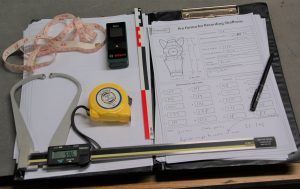
Our measuring equipment and recording form ready for use (Photo: O. Creighton).
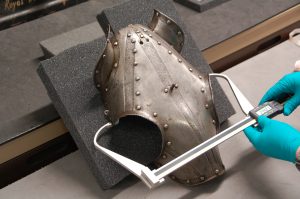
A half shaffron being measured in the Royal Armouries stores (Photo: O. Creighton).
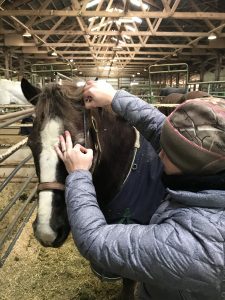
Our honorary fellow Karina Rapp, measuring one of our sample of live horses.
We’ve still got to measure many more shaffrons and horses, but what do we know so far? As you might imagine, horse head size doesn’t have a simple relationship to withers heights, but there is nonetheless some relationship, and we will be able say something about varying stature and head shape. We can already see that shaffrons can be of radically different sizes and some were clearly fitted to pony-sized animals. However, there are some impressively large examples out there too! As our project develops, it will be fascinating to see how our data from shaffrons relate to the zooarchaeaological material, especially in terms of trying to answer the big question about the size and appearance of medieval ‘great’ horses…
I think that analysis of surviving saddles could also be a rich field for research into medieval horse conformation. I have now built around two dozen reproduction war saddles, and a couple of things really puzzle me about the shape of surviving original saddles. One is how narrow they are, and the second is the lack of any cut out for wither clearance. I’d love to know of this is something you are also planning on looking into.
Saddles would be very interesting to look at indeed. Unfortunately however, only very few saddles survive due to the materials used and sadly we probably won’t have the time to look at them properly within the frame of this project.
The 2 points you raise are certainly very interesting and I imagine both might be related to a different way of seating the saddle on the horse’s back. Alternatively, therein might lie an answer to certain pathologies we see in the spine.
We were recently involved in a discussion on Twitter regarding saddles, perhaps you would like to take a look. We’d also love to see some of your saddles – if you’d like to post a few pictures perhaps we can have a discussion on Twitter involving the horse history community.